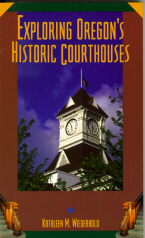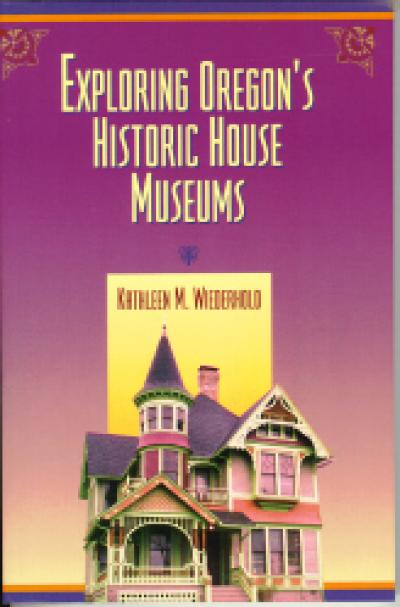
Exploring Oregon's Historic Courthouses
Kathleen M. Wiederhold
Courthouses are often overlooked as significant historical sites, perhaps because they are "working" buildings open to the public. As this informative and entertaining guide proves, however, Oregon courthouses are fascinating places to explore aspects of the state's history.
For this first guide to Oregon's historic courthouses, Kathleen Wiederhold traveled extensively throughout the state visiting courthouses and talking to county officials and local residents. What she discovered were buildings rich in historical meaning and significance. This book explains these buildings and tells their stories, from political drama to salty local lore.
The author introduces twenty-one courthouses in towns and cities from Astoria to Enterprise. Each profile includes a look at the county seat, past and present; a history of the courthouse; a detailed description of the building as it stands today; and tips on what to see.
Exploring Oregon's Historic Courthouses combines local histories and their intriguing anecdotes with valuable information on the state's architectural heritage and old and new photographs of these venerable structures. It offers visitors and readers new opportunities to encounter history and historic architecture in the guise of these living buildings.
About the author
Kathleen M. Wiederhold is a scholar of and an advocate for Oregon's courthouses. She has spent 18 years researching historic buildings and town histories. She has an extensive collection of courthouse memorabilia. She currently lives in Spokane, Washington.
Read more about this author
- I. Introduction
- II. Northwestern Counties
- Benton
- Clackamas
- Clatsop
- Columbia
- Linn
- Multnomah
- Polk
- Tillamook
- Washington
- III. Southwestern Counties
- Douglas
- Jackson
- Josephine
- IV. Eastern Counties
- Baker
- Crook
- Deschutes
- Harney
- Morrow
- Sherman
- Wallowa
- Wasco
- Wheeler
- Other Operating Oregon Courthouses
- Glossary
- Sources Consulted
- Index
They gathered at the Burns church one January night in 1891. The election to determine the county seat was full of fraud, the commissioners had said; the records must go back to the town of Harney. If the records were moved, Burns would not be the county seat and the town could fail. The leaders roused the throng to action; they called them to arms. The hardware merchant supplied weapons to those without guns or rifles. They posted sentinels outside the building that housed the records with instructions to shoot anyone who tried to take them. Armed, determined, they vowed that no other town would be the county seat. Burns would have the courthouse.
An episode like this might seem absurd today, but as the West was settled, competition for economic supremacy pitted town against town, and fortunes were made by winning a railroad depot or county courthouse. The courthouses in this book are at the center of many intriguing stories. Their tales are about people, reveling how they fought for the county seat, built their edifices, and treated the courthouse in subsequent years. Some of these stories are recent history, some took place more than 100 years ago, but many explain what we see today.
The courthouses in this book have endured for well over 50 years, and one form more than 100 years. Each is unique and speaks of a particular time and place. The architect for the 1909 Baker County courthouse, for example, vowed that it would be the finest on the Pacific coast; certainly it was a fitting acquisition for what was then a rich mining town. Tillamook County residents, many of them farmers, constructed their courthouse during the Depression, and even as their austere building was being erected, they eliminated county position in order to save money.
Several board themes revolve around Oregon's historic courthouses, and although many have faded from our consciousness, they still shape what we experience. People wanted the courthouse to be in their town because it was socially and politically prestigious. In addition, being the county seat ensured a level of business activity that helped a town endure and prosper. County workers and attorneys tended to live in the county seat. Out-of-town citizens would shop with the local merchants before or after conducting their business at the courthouse.
While a few counties had just one leading town that clearly would be the county seat, others had several towns fighting for the position. And fight they did. Citizens wrote to their local newspapers, advocating this or that town, but other tactics also were employed. Dallas citizens helped fund a railroad to come to their town so that they would have advantages equal to their rival, Independence. In the Heppner-Lexington contest, someone reportedly drugged a guard posted to protect the election results and stole the ballots.
Courthouses served as the crossroads of the community. There citizens paid taxes, sat on juries, and talked to their commissioners. They recorded the significant events in their lives: births, marriages, and deaths. Social events, such as picnics, took place on the courthouse lawn. On the square or in the building, neighbor met neighbor. While people went to separate churches or joined different fraternal groups, the courthouse belonged to all.
The first courthouses were modest wooden structures, but later citizens built the best brick and stone buildings they could afford. Residents believed their courthouses embodied the economic prospects of the county seat and the county. The Oregon Mist newspaper in St. Helens proclaimed that any newcomer sailing up the Columbia River would see their handsome edifice and know that this was a successful community in which to live and invest.
Of course, courthouses were not solely for impressing the newcomers. Years ago, the buildings were perceived as representing the people themselves. Just as people once dressed for dinner, so they built courthouses with the finest materials and attention to detail--even if no one might notice. In Wasco County's courthouse, a visitor probably would not notice the corners in the lobby, yet workers added half-pilasters to maintain the pattern on the walls. The eagles on the Jackson County courthouse, high above the ground, are so detailed that even the skin on the talons is defined.
Even with a small construction budget, communities wanted their courthouses to appear grand. It was important that the courthouse appear progressive, but not avant-garde, and so Oregon's historic courthouses today display a range of architectural styles as preferences changed. Courthouse architects generally practiced within the state, and some designed courthouses for several Oregon counties. While they did not design nationally recognized architecture, they did create monumental structures that frequently were better than any other building in the county.
Despite changing building styles, courthouses still had to look like courthouses. For the earlier buildings in this book, this meant a tower. If the county could afford it, they installed a clock on the tower, making the courthouse the authority on time when pocket watches were expensive and not everyone had one. This symbol of affluence was so important to the residents of Linn County that, although the architect suggested they build a fireproof vault to protect the records, they chose to fund a clock tower instead.
After the turn of the century, courthouse styles shifted toward classic embellishment, displaying Greek- and Roman-styled columns and cornices. Later, exterior embellishment became more subdued. Regardless of the style, if the county could afford it the exterior was adorned with symbolic decorations. On the classically styled Clatsop County Courthouse, for example, the heads of alternate columns exhibit what appears to be a clerk's ledger, depicting a basic function of county government. The Clackamas County courthouse was constructed during the Depression, but a reporter for the local newspaper at the time defended the courthouse's decoration because it added meaning. The courthouse exterior displays sculptures of two men, each holding an omniscient eye, which, according to the reporter, should inspire the sheriff to watch out for "Monkey business."
Many counties followed a national tradition and built their courthouses on a square. The locations of these blocks vary; some are in the center of town and others on the edge of development. A few lay prominently on a hill. For some Oregon county seats today, the courthouse square is the only park-like setting among the town's buildings, and maintaining the landscaping is an important part of keeping up appearances.
Over the years, courthouse squares have become a place for community mementos. The square usually serves as the place to commemorate local men and women killed in the country's wars. Other items, telling of some aspect of the county's past, also are set on the square: a set of logging wheels, a pair of grist mill stones, a cornerstone from a demolished courthouse.
Since courthouses are open to the public, one can explore the building interiors. Like the exteriors, the lobby or main hallway can be opulent or economical, depending on the construction budget. here, many of Oregon's historic courthouses are relatively true to their early design, so that one can view a classically interpreted or Art Deco finish. Some have been refurbished in an attempt to "modernize," but most retain a sense of their original appearance.
Equipped with just a little background knowledge, a visitor sees nuances in the community mementos displayed. Albany was a town divided by its Republican and Democratic political beliefs; although the Republicans symbolically claimed the square by placing a bench there, the Democrats captured the building by displaying a picture of President Franklin Roosevelt in the lobby. Medford started as a railroad town, and the train station benches in the courthouse tie the town to its early beginnings. In the Morrow County courthouse, a photographic display of the 1903 flood in Heppner reveals an important event in the town's history.
To the careful observer, the courthouse also can disclose attitudes, both past and present. The doorways to the restrooms in the Wallowa County courthouse are smaller than those of a typical office, suggesting some modesty in concealing these necessities. In Wasco County's courthouse, the interest in preserving the historic atmosphere of the building was so great that modern trash containers have plastic laminated surrounds that match the marble wainscoting.
The main courtrooms are formal rooms where interior decoration and symbolism were made as grand as the budget would allow. Courtrooms served as a place to administer justice and sometimes as a site of general community meetings. Even if they initially may have appeared similar, courtrooms have evolved into distinct places. The same architect designed the courthouses in Wheeler and Sherman counties, but today the jury in the Wheeler County courthouse sits on what appear to be old movie theater seats, possibly salvaged from the defunct theater in Fossil. In the Sherman County courthouse, by contrast, the jury sits on brightly colored high school stadium pads that read "Sherman County Huskies."
Over the years, courthouses have undergone some alterations. Modern glass doors have replaced wooden ones; aluminum windows have supplanted those with wooden sashes. In Clatsop County, The glass and copper dome was removed; in Sherman County, the tower. In Polk and Baker counties, stairways were eliminated when additions were constructed. For many counties, newer additions reflect changes in attitudes about county buildings: they should be constructed as inexpensively as possible. This belief makes the older courthouses more valuable than ever.
The goal of this book is to help the reader appreciate courthouses on a deeper level. rich in meaning, courthouses represent the nation's political ideals, a county's aspirations, a community's pride, and a people's gathering place. This book explains these buildings, suggesting where to look and what is important. After exploring this book, the reader will be able to look at courthouses, either in Oregon or elsewhere, with a more developed eye. Furthermore, he or she will be more aware of how other buildings, not just courthouses, communicate through their design and embellishment.
Oregon's historic courthouses exist in a civic setting, and to examine the courthouse without understanding the county seat is to limit one's experience of the building. The courthouse has influenced the county seat, but in turn the county seat has influenced the courthouse. In many towns, the ties between the two began when the community was very young. Each of the county seats in this book is unique. Although Astoria and St. Helens both stand beside the Columbia River, they are different due to distinct histories. Corvallis and Albany stand in the Willamette Valley just twelve miles from each other, but they have different personalities because of their past. To understand this influence on the courthouse, this book explores the events that fashioned the county seat. how did it start? What made it grow?
The past shapes what we see today in these towns. A town's history gives it personality. In Baker City, nearby gold discoveries led to a wealth of downtown buildings. St Helens with its industries once was called "Payroll City," and today its Main Street leads directly to what was its first great lumber mill. In Grants Pass, turn-of-the-century structures still line the street opposite the site of a demolished train depot.
It also is important to understand how the courthouse evolved. Although this book explores the early county buildings, it places particular emphasis on the issues and attitudes about the present courthouse when it was built. The buildings often were the center of great controversy, some of it amusing in retrospect. While records of county meetings ted to be sparse, the newspaper in the county seat generally followed the courthouse's progress from preliminary discussion to final dedication.
With an understanding of the county seat and the history of the courthouse, this book investigates courthouses today. These are living buildings that can be explored and admired. For many of us, history is most vivid when we can experience its legacies personally. Fortunately, change occurs very slowly in courthouses, and many people throughout Oregon protect the historic integrity of their courthouse.
A few counties, such as Jackson, have former courthouses that are still standing. Although the book discusses these former courthouses, my emphasis is on the operating courthouse. Other tenants occupy the former courthouses and significant alterations have occurred to some.
This book explores only Oregon's historic courthouses, which I have defined as those completed before 1950. During the 1950's a wave of courthouse construction occurred in Oregon, but the design of these new buildings, following then widespread architectural trends, displayed bland, simplified facades that bore a strong resemblance to generic office buildings. Consequently, many lost the affection of the public.
Each chapter in the book is devoted to one county and is self-contained, allowing the reader to explore that county without consulting prior chapters. Each chapter is divided into four sections: the history of the county seat, visiting the county seat today, the history of the courthouse and the courthouse today.
I used a variety of sources for this book: local histories, clipping files of various historical societies and public libraries, and county seat newspapers. I interviewed judges, county employees, local historians, and knowledgeable citizens. I toured the courthouses extensively. sometimes during my inspection I was joined by a custodian or maintenance person, generally the person who knows the courthouse the most intimately.
Courthouses are open during regular office hours. Courts may be in session, requiring respectful behavior from visitors, and a few places such as private offices or the clock towers may be closed to the public. But for the most part, the mysterious marked tiles in the Baker County courthouse are accessible to all. The visitor should move slowly through a courthouse, as there is much to see.



